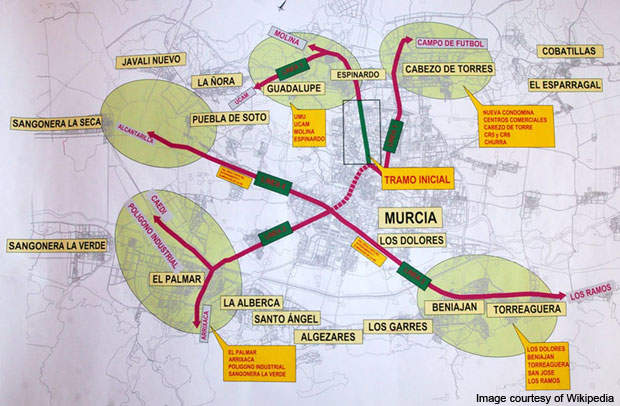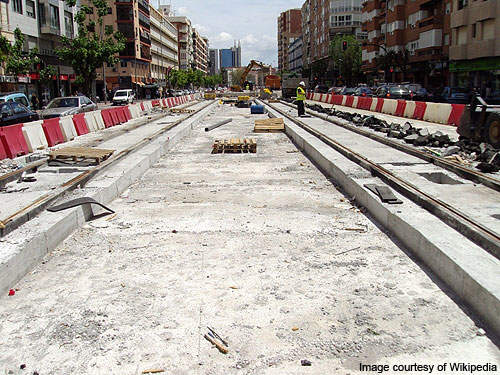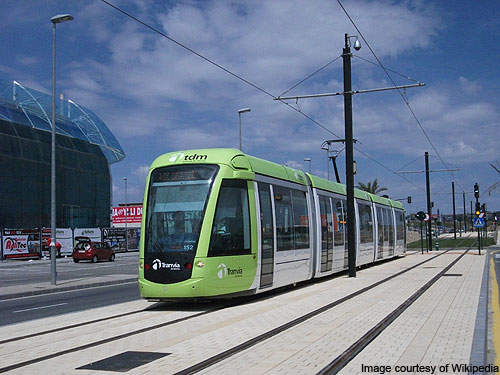Murcia, the seventh largest city in Spain, launched its first tram services on the 17.5km long Tram Line 1 in June 2011. The ‘V’ shaped line runs from Estadio Nueva Condomina in the north-east to University of Murcia campus in the north-west.
A 2.2km-long pilot section of Line 1 was inaugurated in April 2007. The pilot line runs along the Avenida Juan Carlos I area.
Tram Line 1, including the pilot section, is being operated by Tranvía de Murcia under a 40-year concession contract. Tranvía de Murcia is a joint venture of FCC Construction (60%) and Comsa-Emte (40%).
Trams run every 10 and 15 minutes during peak and non-peak hours respectively. The journey between the two terminals takes 34 minutes.
The line is expected to carry 5.5 million passengers in the first year of operation. By the end of the 40th year, the passenger capacity is expected to increase to 20 million a year. As of June 2011, the city of Murcia has a population of 430,000.
Lines and routes
It is planned that the Murcia tram system will have four lines in total. Tram Line 1 will have interchanges at Plaza Circular and Red Nacional de Ferrocarriles Españoles (RENFE) stations upon completion of the planned Tram Lines 2, 3 and 4.
Line 1 begins at Estadio Nueva Condomina and runs southwards, forming a ‘V’ shape between Marina Española and Plaza Circular. It further runs along the pilot section of Juan Carlos I to Los Rectores Terra Natura where it forms a circular loop connecting Servicios de Investigación, Centro Social, Biblioteca General and Residencia Universitaria.
It then branches out from Los Rectores Terra Natura to connect to Los Jerónimos, a catholic university in Guadalupe.
Project details
Successful operation of the initial 2.2km pilot section resulted in the decision to complete Tram Line 1. Tenders were invited in August 2008 to construct the remaining length.
Sociedad Concesionaria Tranvía de Murcia won the €264m concession contract in April 2009 to build, maintain and operate the Tram Line 1 for 40 years. Tranvía de Murcia received €130m funding for the project from Madrid Western Light Railways.
Line 1 runs on a 1,435mm gauge system. The tracks were built by laying concrete slabs and rails weighing 60kg/m each were welded to form long bars. Cobblestones were laid on the either side of the track.
The section between Universidad de Murcia and Nueva Condomina is 11.5km long and has double tracks. The branch line and the circular loop, which are both 3km long, have single track.
Emte Sistemas provided an integrated system to plan, manage and operate the line.
Infrastructure
Tram Line 1 has a total of 28 stops (24 along the main line and four along the branch) located at an average distance of 625m from each other. The intermediate stations between the terminals are La Ladera, Infantas, Principe Fellipe, Churra, Alameda, Los Cubos, Santiago y Zaraiche, Principe de Asturias, Abenarabi, Marina Española, Plaza Circular, Juan Carlos I, Biblioteca Regional, Sende De Granada, Parque Empresarial, El Puntal, Espinardo, Los Rectores Terra Natura, Servicios de Investigacion, Centro Social, Biblioteca General and Residencia Universitaria.
The branch section from Los Rectores Terra Natura stops at Guadalupe, Reyes Catolicos, EL Porton and Los Jerónimos.
All the stations have 40m-long sheltered platforms. Around 12 stations have platforms on either side, eight stations have central platforms and the remaining eight have single-track side platforms. The central platforms are 4m wide while the side platforms are 2.5m wide.
The maintenance facility is situated near Nueva Condomina. It has 10 tracks, three of which go to the workshop and four to the uncovered depot. The other three tracks are used respectively for internal connection, servicing and siding for auxiliary vehicles.
E-ticketing systems are installed at all the stations to provide easy and quick access to passengers, particularly those with limited mobility. These machines were supplied by Hoeft & Wessel in association with their Spanish partner Ikusi.
Signalling and communication
Murcia Tram Line 1 works on a mobile-radio communications network. All the trams are installed with IAP TeNMS-lite systems based on Tetra-technology to communicate between the stations in emergencies. The communication system was supplied by IAPsolutions.
Rolling stock
Tram Line 1 is being serviced by a fleet of 11 Citidis 302 trams manufactured by Alstom. The trams were originally procured for the Madrid tramway network, but were sold to the concessionaire in 2009 to serve the Murcia tramway line.
The Citadis 302 trams are bi-directional. The 32.3m-long and 2.4m-wide trams run on 750V DC overhead lines. The power is supplied by seven substations located along the route.
While the Citidis 302 is designed to run at a top speed of 50km/h, the trams operate at a commercial speed of 23km/h and 27km/h on the main and branch line respectively.
Each side of the tram has four double and two single doors. The tram has capacity for 186 passengers with 54 seats. The cars are air-conditioned and installed with electronic indication systems at the end and on the sides.
Future
The planned Tram Lines 2, 3 and 4 are expected to run in an east-west direction and north-south direction covering the entire city.
The east-west line will run between Los Eamos and Alcantarilla and the north-south line between Campo De Futbol and Arrxaca.






